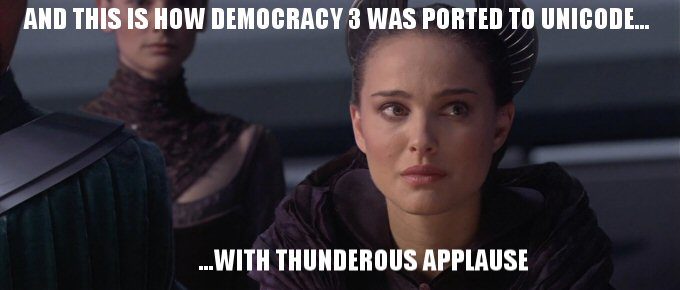Democracy is the game I’m best known for. Its the ONLY game I have made three versions of. The very first version was released back before the invention of color television when I was really young. Winston Churchill gave it decent reviews, and the rest is history. It remains my best-selling game to-date, and the one that has got me by far the most press attention, as you would expect given the subject matter and title. The list of weird offers and proposals and deals I have discussed with people over the years (including foreign governments and military institutions) has provided me with enough interesting anecdotes to compensate for my inherent boringness. Its been a fun ride.
Because Democracy 3 was built on Democracy 2, which was built on Democracy 1… there were some coding decisions made right at the start that effectively bit me in the backside years later. The most obvious two were the dependence on directx9 (meaning no cross platform capability) and the development in ASCII (well… MBCS) instead of Unicode. The game was incredibly popular, so not having mac or ipad or linux versions AND not being able to do a Chinese / Russian version was kinda silly and had to be fixed eventually.
With this in mind, I hired people to make a mac port of the game, and for a long time we had linux and OSX versions, even eventually ipad versions of the game. They make up about 10% of revenue (9% mac, 1% Linux), and definitely have paid for themselves over the long run (although I was sceptical at the start. The linux build existed purely as a humble-bundle price-of-admission at the time). The ipad build is *sub optimal*, due to the RAM limitations in the device, but still, it has turned out to be profitable in the long run.
A while ago now, I decided that it made sense to bite the bullet and have the game translated into Unicode, which would allow for non-western character sets, and thus Chinese and Russian support. Who could resist the opportunity to bring Democracy to Russia and China right? After all, as Spock explains in Star Trek 6: “Only cliffski could go to china”. I HATE middleware, and hate compiler/development environment bullshit, so I had always avoided it, so it wasn’t until Jeff Sheen (Stargazy studios) offered to handle it, that I actually got around to making it happen.
The next part of this story contains so much grief, hassle, WTF moments and ‘how the hell is this even possible’ mini-stories that it is surely worthy of a Klingon opera, or a Netflix miniseries. The short version is that yes, its 2018 and still if you want to code a game and have it seamlessly support Unicode for both display and text entry, and support every possible language known to man AND also run on really old hardware (which often blatantly LIES about its capabilities…) then you are in for a world of pain. A lot of games *claim* to support Chinese and Russian character sets, but they are not doing so fully, they just create a huge sprite-sheet of the few characters they use, and dont allow for modding or user input. Modding is a huge part of Democracy 3 and we wanted to do it properly.

So anyway… today is the day I am declaring that yup.. its done. Finished. Finito. DONEZO, Completahontas maximus rex. IT.IS.DONE. TYhe updates to Democracy 3 we sneaked out (purely Unicode-related bugfixes) last week are the final ones. Development on Democracy 3 is FINISHED. After 4 expansion packs (Social Engineering, Extremism, Clones & Drones and Electioneering), Ports to Ipad, Linux and OSX, and translation into a long list of languages…we are done. I’m sure that it still crashes or wont run for 0.1% of potential players (which is actually a lot for a game that popular), but at a certain point, you just have to accept that PCs are VERY variable, and you will never have 100% compatibility.
Now you might think that with everything that is happening politically in the world right now, surely this would be a good time to be working on a political game, not a good time to finish working on one.
And I say to you people who think this… follow me on twitter or bookmark this blog :D.